Properties of Magnetic Field Fluctuations in Long-Lasting Radial IMF Events from Wind Observation
Abstract
:1. Introduction
2. Data
3. Results
3.1. Characteristic of PSD for Radial IMF Events
3.2. Temperature Anisotropy and β
3.3. Observations of Waves
- Each PSD was fitted with a linear fit in a log-log scale.
- The fitted profile was subtracted from the original PSD (compensated PSD).
- The frequency range below 0.01 Hz was omitted.
- The maximum of compensated PSD was found.
- Only PSDs with a peak exceeding 0.5 were selected.
- The remaining PSDs were checked on the coherence of BY and BZ (perpendicular components).
- Only PSDs exhibiting coherence above 0.8 in more than 10% of the observed points (10 min) were accepted.
- Finally, 485 intervals with wave structures (from 2393 intervals) were selected for further analysis.
4. Discussion
5. Conclusions
- The fluctuation powers are low in the radial IMF events in both MHD and kinetic ranges, which is consistent with the previous observational results showing that the power increases with increasing cone angle (from 6.0 to 3.4 nT2/Hz in the MHD range and 0.0026 to 0.0010 nT2/Hz in the kinetic range).
- Although the observed fluctuation power is low, the above conclusion can be misleading due to observation limitations. The dominant 2D component of the magnetic fluctuation is hard to observe because the sampling direction is aligned with the mean magnetic field.
- Compared with the adjacent regions, the median slope of the PSD is slightly steeper (−2.5) in the kinetic range and less steep in the MHD range (−1.5), but the formerly reported dependence of the PSD slope on the cone angle is missing in the radial IMF events. It might be related to the development of turbulence in long-lasting radial IMF intervals. An over-expansion forming these intervals can result in a flatter slope of the solar wind magnetic fluctuations.
- The temperature is more isotropic in the radial IMF events. We suggest that radial expansion in these events is larger than that in a typical Parker-spiral structure, and it leads to the enhancement of parallel cooling. On the other hand, stochastic processes can more efficiently heat protons in perpendicular direction in a low plasma with a small angle between the alpha particle and proton speeds.
- The occurrence rate of wavy structures in the frequency range above 0.01 Hz is higher in radial IMF events. This result is consistent with the distribution of TANI-, showing that the proton cyclotron instability has a higher chance to be excited in the radial IMF events.
- We did not find a clear preferred wave polarization in the radial IMF events in a frequency range from 0.1 to 1 Hz, but the right-hand polarized waves are observed slightly more frequently than the left-hand ones.
Author Contributions
Funding
Data Availability Statement
Acknowledgments
Conflicts of Interest
References
- Shue, J.H.; Chao, J.K.; Fu, H.C.; Russell, C.T.; Song, P.; Khurana, K.K.; Singer, H.J. A new functional form to study the solar wind control of the magnetpause size and shape. J. Geophys. Res. 1997, 102, 9497–9511. [Google Scholar] [CrossRef]
- Sibeck, D.G.; Lin, R.-Q. Size and shape of the distant magnetotail. J. Geophys. Res. Space Phys. 2014, 119, 1028–1043. [Google Scholar] [CrossRef]
- Dungey, J.W. Interplanetary magnetic field and the auroral zone. Phys. Rev. Lett. 1961, 6, 47–48. [Google Scholar] [CrossRef]
- Dungey, J.W. The Structure of the Ionosphere, or Adventures in Velocity Space. In Geophysics: The Earth’s Environment; Dewitt, C., Hieblot, J., Lebeau, A., Eds.; Gordon and Breach: New York, NY, USA, 1963; pp. 503–550. [Google Scholar]
- Bier, E.A.; Owusu, N.; Engebretson, M.J.; Posch, J.L.; Lessard, M.R.; Pilipenko, V.A. Investigating the IMF cone angle control of Pc3-4 pulsations observed on the ground. J. Geophys. Res. Space Phys. 2014, 119, 1797–1813. [Google Scholar] [CrossRef]
- Pi, G.; Němeček, Z.; Šafránková, J.; Grygorov, K.; Shue, J.-H. Formation of the dayside magnetopause and its boundary layers under the radial IMF. J. Geophys. Res. Space Phys. 2018, 123, 3533–3547. [Google Scholar] [CrossRef] [Green Version]
- Pi, G.; Shue, J.-H.; Chao, J.-K.; Němeček, Z.; Šafránková, J.; Lin, C.-H. A reexamination of long-duration radial IMF events. J. Geophys. Res. Space Phys. 2014, 119, 7005–7011. [Google Scholar] [CrossRef]
- Gosling, J.T.; Skoug, R.M. On the origin of radial magnetic fields in the heliosphere. J. Geophys. Res. 2002, 107, 1327. [Google Scholar] [CrossRef]
- Schwadron, N.A. An Explanation for Strongly Underwound Magnetic Field in Co-rotating Rarefaction Regions and its Relationship to Footpoint Motion on the the Sun. Geophys. Res. Lett. 2002, 29, 8-1–8-4. [Google Scholar] [CrossRef] [Green Version]
- Klein, K.G.; Howes, G.G.; TenBarge, J.M.; Podesta, J.J. Physical interpretation of the angle-dependent magnetic helicity spectrum in the solar wind: The nature of turbulent fluctuations near the proton cyroradius scale. APJ 2014, 785, 138. [Google Scholar] [CrossRef] [Green Version]
- Horbury, T.S.; Forman, M.; Oughton, S. Anisotropic Scaling of Magnetohydrodynamic Turbulence. Phys. Rev. Lett. 2008, 101, 175005. [Google Scholar] [CrossRef] [Green Version]
- Podesta, J.J. Dependence of solar-wind power spectra on the direction of the local mean magnetic field. APJ 2009, 698, 986–999. [Google Scholar] [CrossRef]
- Duan, D.; He, J.; Bowen, T.A.; Woodham, L.D.; Wang, T.; Chen, C.H.K.; Mallet, A.; Bale, S.D. Anisotropy of Solar Wind Turbulence in the Inner Heliosphere at Kinetic Scales: PSP Observations. ApJL 2021, 915, L8. [Google Scholar] [CrossRef]
- Wicks, R.T.; Horbury, T.S.; Chen, C.H.K.; Schekochihin, A.A. Power and spectral index anisotropy of the entire inertial range of turbulence in the fast solar wind. Mon. Not. R. Astron. Soc. Lett. 2010, 407, L31. [Google Scholar] [CrossRef] [Green Version]
- He, J.; Tu, C.; Marsch, E.; Bourouaine, S.; Pei, Z. Radial evolution of the wavevector anisotrooy of solar wind turbulence between 0.3 and 1 AU. APJ 2013, 773, 72. [Google Scholar] [CrossRef] [Green Version]
- Wang, X.; Tu, C.; He, J.; Marsch, E.; Wang, L. The influence of intermittency on the spectral anisotropy of solar wind turbulence. ApJL 2015, 810, L21. [Google Scholar] [CrossRef]
- Wu, H.; Tu, C.; Wang, X.; He, J.; Yang, L.; Wang, L. Isotropic Scaling Features Measured Locally in the Solar Wind Turbulence with Stationary Background Field. APJ 2020, 892, 138. [Google Scholar] [CrossRef]
- Zank, G.P.; Nakanotani, M.; Zhao, L.-L.; Adhikari, L.; Telloni, D. Spectral Anisotropy in 2D plus Slab Magnetohydrodynamic Turbulence in the Solar Wind and Upper Corona. APJ 2020, 900, 115. [Google Scholar] [CrossRef]
- Oughton, S.; Matthaeus, W.H. Critical Balance and the Physics of Magnetohydrodynamic Turbulence. Astrophys. J. 2020, 897, 37. [Google Scholar] [CrossRef]
- Suvorova, A.V.; Shue, J.-H.; Dmitriev, A.V.; Sibeck, D.G.; McFadden, J.P.; Hasegawa, H.; Ackerson, K.; Jelínek, K.; Šafránková, J.; Němeček, Z. Magnetopause expansions for quasi-radial interplanetary magnetic field: THEMIS and Geotail observations. J. Geophys. Res. 2010, 115, A10216. [Google Scholar] [CrossRef] [Green Version]
- Suvorova, A.V.; Dmitriev, A.V. Magnetopause inflation under radial IMF: Comparison of models. Earth Space Sci. 2015, 2, 107–114. [Google Scholar] [CrossRef]
- Telloni, D.; Carbone, F.; Bruno, R.; Sorriso-Valvo, L.; Zank, G.P.; Adhikari, L.; Hunana, P. No Evidence for Critical Balance in Field-aligned Alfvenic Solar Wind Turbulence. Astrophys. J. 2019, 887, 160. [Google Scholar] [CrossRef]
- Ogilvie, K.W.; Chornay, D.J.; Fritzenreiter, R.J.; Hunsaker, F.; Keller, J.; Lobell, J.; Miller, G.; Scudder, J.D.; Sittler, E.C., Jr.; Torbert, R.B.; et al. SWE, A comprehensive plasma instrument for the Wind spacecraft. Space Sci. Rev. 1995, 71, 55–77. [Google Scholar] [CrossRef]
- Lepping, R.P.; Acuna, M.H.; Burlaga, L.F.; Farrall, W.M.; Slavin, J.A.; Schatten, K.H.; Mariani, F.; Ness, N.F.; Neubauer, F.M.; Whang, Y.C.; et al. The WIND magnetic field investigation. Space Sci. Rev. 1995, 71, 207–229. [Google Scholar] [CrossRef]
- Torrence, C.; Compo, G.P. A practical guide to wavelet analysis. Bull. Am. Meteorol. Soc. 1998, 79, 61–78. [Google Scholar] [CrossRef] [Green Version]
- Lion, S.; Alexandrova, O.; Zaslavsky, A. Coherent Events and Spectral Shape at Ion Kinetic Scales in the Fast Solar Wind Turbulence. Astrophys. J. 2016, 824, 47. [Google Scholar] [CrossRef] [Green Version]
- Woodham, L.D.; Wicks, R.T.; Verscharen, D.; Owen, C.J. The Role of Proton Cyclotron Resonance as a Dissipation Mechanism in Solar Wind Turbulence: A Statistical Study at Ion-kinetic Scales. APJ 2018, 856, 49. [Google Scholar] [CrossRef]
- Pi, G.; Pitňa, A.; Němeček, Z.; Šafránková, J.; Shue, J.-H.; Yang, Y.-H. Long- and Short-Term Evolutions of Magnetic Field Fluctuations in High-Speed Streams. Sol. Phys. 2020, 295, 84. [Google Scholar] [CrossRef]
- Safrankova, J.; Nemecek, Z.; Nemec, F.; Prech, L.; Chen, C.H.K.; Zastenker, G.N. Power Spectral Density of Fluctuations of Bulk and Thermal Speeds in the Solar Wind. Astrophys. J. 2016, 825, 121. [Google Scholar] [CrossRef] [Green Version]
- Mullan, D.J.; Smith, C.W. Solar wind statistics at 1 AU: Alfven speed and plasma beta. Sol. Phys. 2006, 234, 325–338. [Google Scholar] [CrossRef]
- Němeček, Z.; Šafránková, J.; Němec, F.; Ďurovcová, T.; Pitňa, A.; Alterman, B.L.; Voitenko, Y.M.; Pavlů, J.; Stevens, M.L. Spectra of Temperature Fluctuations in the Solar Wind. Atmosphere 2021, 12, 1277. [Google Scholar] [CrossRef]
- Bale, S.D.; Kasper, J.C.; Howes, G.G.; Quataert, E.; Salem, C.; Sundkvist, D. Magnetic Fluctuation Power Near Proton Temperature Anisotropy Instability Thresholds in the Solar Wind. Phys. Rev. Lett. 2009, 103, 211101. [Google Scholar] [CrossRef] [PubMed] [Green Version]
- Hellinger, P.; Trávníček, P.; Kasper, J.C.; Lazarus, A.J. Solar wind proton temperature anisotropy: Linear theory and WIND/SWE observations. Geophys. Res. Lett. 2006, 33, L09101. [Google Scholar] [CrossRef] [Green Version]
- Torrence, C.; Webster, P.J. Interdecadal changes in the ENSO-monsoon system. J. Clim. 1999, 12, 2679–2690. [Google Scholar] [CrossRef] [Green Version]
- Bruno, R.; Carbone, V. The solar wind as a turbulence laboratory. Lining Rev. Sol. Phys. 2013, 10, 2. [Google Scholar] [CrossRef] [Green Version]
- Jian, L.K.; Wei, H.Y.; Russell, C.T.; Luhmann, J.G.; Klecker, B.; Omidi, N.; Isenberg, P.A.; Goldstein, M.L.; Figueroa-Viñas, A.; Blanco-Cano, X. Electromagnetic waves near the proton cyclotron frequency: STEREO observations. Astrophys. J. 2014, 786, 123. [Google Scholar] [CrossRef]
- Zank, G.P.; Adhikari, L.; Shiota, P.H.D.; Bruno, R.; Telloni, D. Theory and Transport of Nearly Incompressible Magnetohydrodynamic Turbulence. APJ 2017, 835, 147. [Google Scholar] [CrossRef]
- Chen, C.H.K.; Wicks, R.T.; Horbury, T.S.; Schekochihin, A.A. Interpreting power anisotropy measurements in plasma turbulence. ApJL 2010, 711, L79. [Google Scholar] [CrossRef] [Green Version]
- Pitňa, A.; Šafránková, J.; Němeček, Z.; Franci, L.; Pi, G. A Novel Method for Estimating the Intrinsic Magnetic Field Spectrum of Kinetic-Range Turbulence. Atmosphere 2021, 12, 1547. [Google Scholar] [CrossRef]
- Goldreich, P.; Sridhar, S. Toward a theory of interstellar turbulence II. Strong Alfvénic turbulence. APJ 1995, 438, 763. [Google Scholar] [CrossRef]
- Boldyrev, S. Spectrum of Magnetohydrodynamic Turbulence. Phys. Rev. Lett. 2006, 96, 115002. [Google Scholar] [CrossRef] [Green Version]
- Verdini, A.; Grappin, R.; Alexandrova, O.; Franci, L.; Landi, S.; Matteini, L.; Papini, E. Three-dimensional local anisotropy of velocity fluctuations in the solar wind. Mon. Not. R. Astron. Soc. 2019, 486, 3006–3018. [Google Scholar] [CrossRef]
- Woodham, L.D.; Wicks, R.T.; Verscharen, D.; TenBarge, J.M.; Howes, G.G. Dependence of Solar Wind Proton Temperature on the Polarization Properties of Alfvenic Fluctuations at Ion-kinetic Scales. Astrophys. J. 2021, 912, 101. [Google Scholar] [CrossRef]
- Gary, S.P.; Borovsky, J.E. Alfvén-cyclotron fluctuations: Linear Vlasov theory. J. Geophys. Res. Space Phys. 2004, 109, A6. [Google Scholar] [CrossRef]
- Chandran BD, G.; Li, B.; Rogers, B.N.; Quataert, E.; Germaschewski, K. Perpendicular Ion Heating by Low-frequency Alfvén-wave Turbulence in the Solar Wind. APJ 2010, 720, 503C. [Google Scholar] [CrossRef]
- Zhao, G.Q.; Feng, H.Q.; Wu, D.J.; Huang, J.; Zhao, Y.; Liu, Q.; Tian, Z.J. Dependence of Ion Temperatures on Alpha–Proton Differential Flow Vector and Heating Mechanisms in the Solar Wind. ApJL 2020, 889, L14. [Google Scholar] [CrossRef]
- Zhao, G.Q.; Lin, Y.; Wang, X.Y.; Wu, D.J.; Feng, H.Q.; Liu, Q.; Zhao, A.; Li, H.B. Observational Evidence for Solar Wind Proton Heating by Ion-Scale Turbulence. Geophys. Res. Lett. 2020, 47, 18. [Google Scholar] [CrossRef]
- Zhao, G.Q.; Lin, Y.; Wang, X.Y.; Feng, H.Q.; Wu, D.J.; Li, H.B.; Zhao, A.; Liu, Q. Magnetic Helicity Signature and Its Role in Regulating Magnetic Energy Spectra and Proton Temperatures in the Solar Wind. APJ 2021, 906, 123. [Google Scholar] [CrossRef]
- Telloni, D.; Carbone, F.; Bruno, R.; Zank, G.P.; Sorriso-Valvo, L.; Mancuso, S. Ion Cyclotron Waves in Field-aligned Solar Wind Turbulence. Astrophys. J. Lett. 2019, 885, L5. [Google Scholar] [CrossRef]
- Podesta, J.J.; Gary, S.P. Magnetic helicity spectrum of solar wind fluctuations as a function of the angle with respect to the local mean magnetic field. APJ 2011, 734, 15. [Google Scholar] [CrossRef]
- Jian, L.K.; Russell, C.T.; Luhmann, J.G.; Anderson, B.J.; Boardsen, S.A.; Strangeway, R.J.; Cowee, M.M.; Wennmacher, A. Observations of ion cyclotron waves in the solar wind near 0.3 AU. J. Geophys. Res. Space Phys. 2010, 115. [Google Scholar] [CrossRef] [Green Version]
- He, J.S.; Tu, C.Y.; Marsch, E.; Yao, S. Do Oblique Alfven/Ion-Cyclotron or Fast-Mode/Whistler Waves Dominate the Dissipation of Solar Wind Turbulence near the Proton Inertial Length? Astrophys. J. Lett. 2012, 745, L8. [Google Scholar] [CrossRef]
- Zhao, G.Q.; Feng, H.Q.; Wu, D.J.; Liu, Q.; Zhao, U.; Zhao, A.; Huang, J. Statistical study of low-frequency electromagnetic cyclotron waves in the solar wind at 1 AU. J. Geophys. Res. Space Phys. 2018, 123, 1715–1730. [Google Scholar] [CrossRef]
- Zhao, G.Q.; Chu, Y.H.; Lin, P.H.; Yang, Y.-H.; Feng, H.Q.; Wu, D.J.; Liu, Q. Low-frequency electromagnetic cyclotron waves in and around magnetic clouds: STEREO observations during 2007–2013. J. Geophys. Res. Space Phys. 2017, 122, 4879–4894. [Google Scholar] [CrossRef]
- Jian, L.K.; Moya, P.S.; Vinas, A.F.; Stevens, M. Electromagnetic Cyclotron Waves in the Solar Wind: Wind Observation and Wave Dispersion Analysis. AIP Conf. Proc. 2016, 1720, 040007. [Google Scholar] [CrossRef]
- Wicks, R.T.; Alexander, R.L.; Stevens, M.; Wilson, L.B.; Moya, P.S.; Vinas, A.; Jian, L.K.; Roberts, D.A.; O’Modhrain, S.; Gilbert, J.A.; et al. A Proton-Cyclotron Wave Storm Generated by Unstable Proton Distribution Functions in the Solar Wind. Astrophys. J. 2016, 819, 6. [Google Scholar] [CrossRef] [Green Version]
- Bruno, R.; Telloni, D. Spectral Analysis of Magnetic Fluctuations at Proton Scales from Fast to Slow Solar Wind. Astrophys. J. Lett. 2015, 811, L17. [Google Scholar] [CrossRef] [Green Version]
- He, J.S.; Marsch, E.; Tu, C.; Yao, S.; Tian, H. Possible Evidence of Alfven-Cyclotron Waves in the Angle Distribution of Magnetic Helicity of Solar Wind Turbulence. Astrophys. J. 2011, 731, 85. [Google Scholar] [CrossRef]
- He, J.S.; Tu, C.Y.; Marsch, E.; Yao, S. Reproduction of the Observed Two-Component Magnetic Helicity in Solar Wind Turbulence by a Superposition of Parallel and Oblique Alfven Waves. Astrophys. J. 2012, 749, 86. [Google Scholar] [CrossRef] [Green Version]

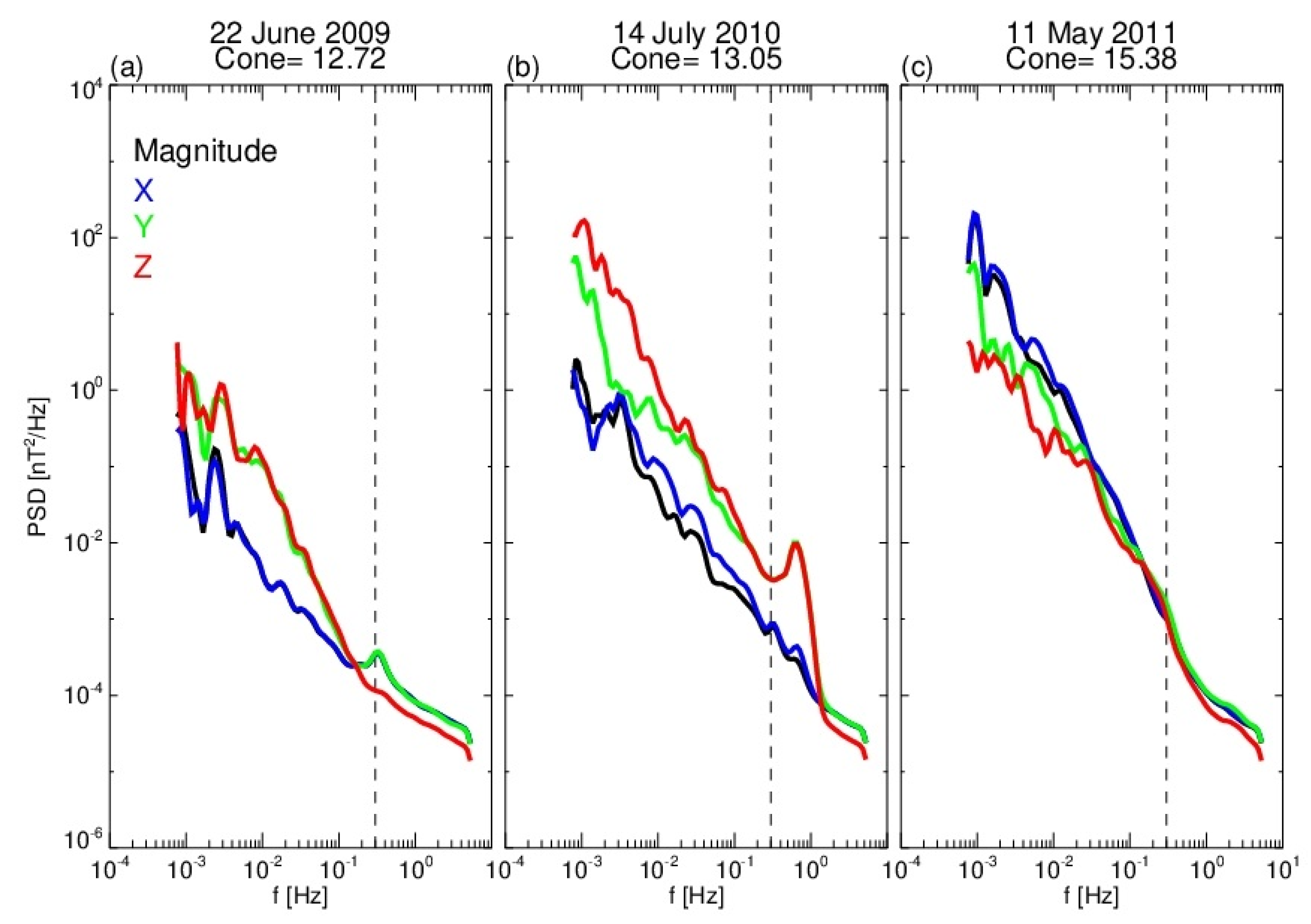


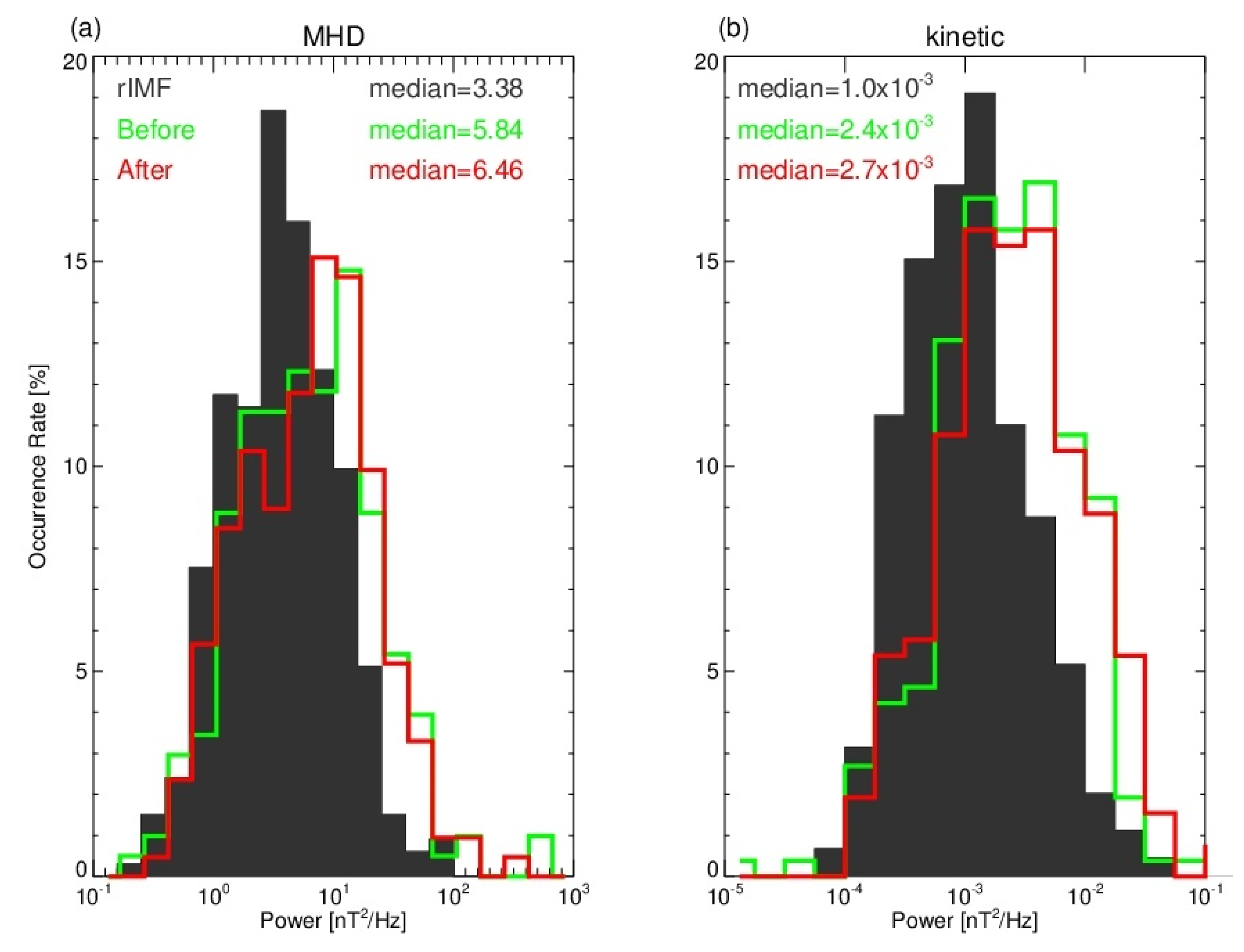
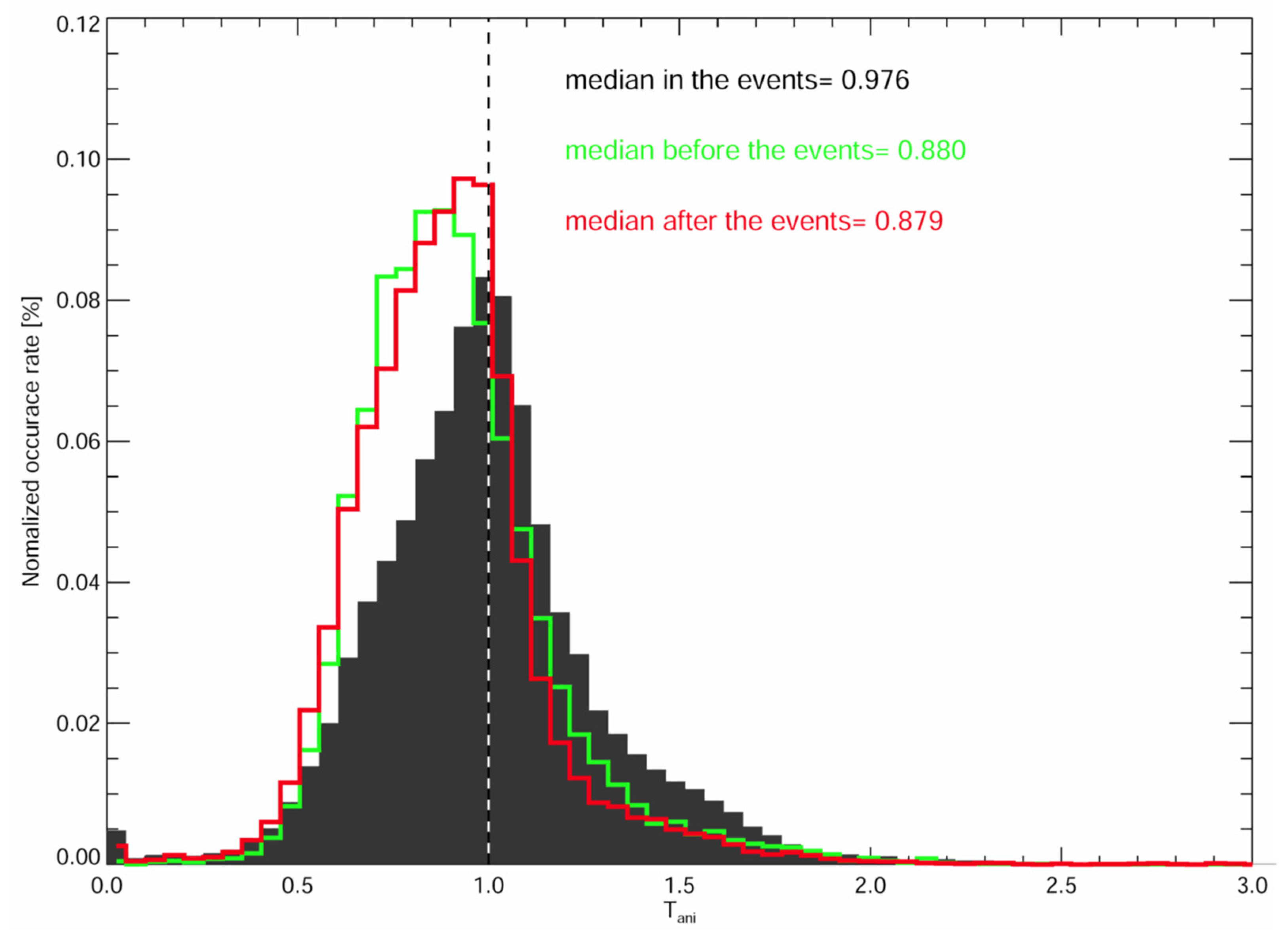
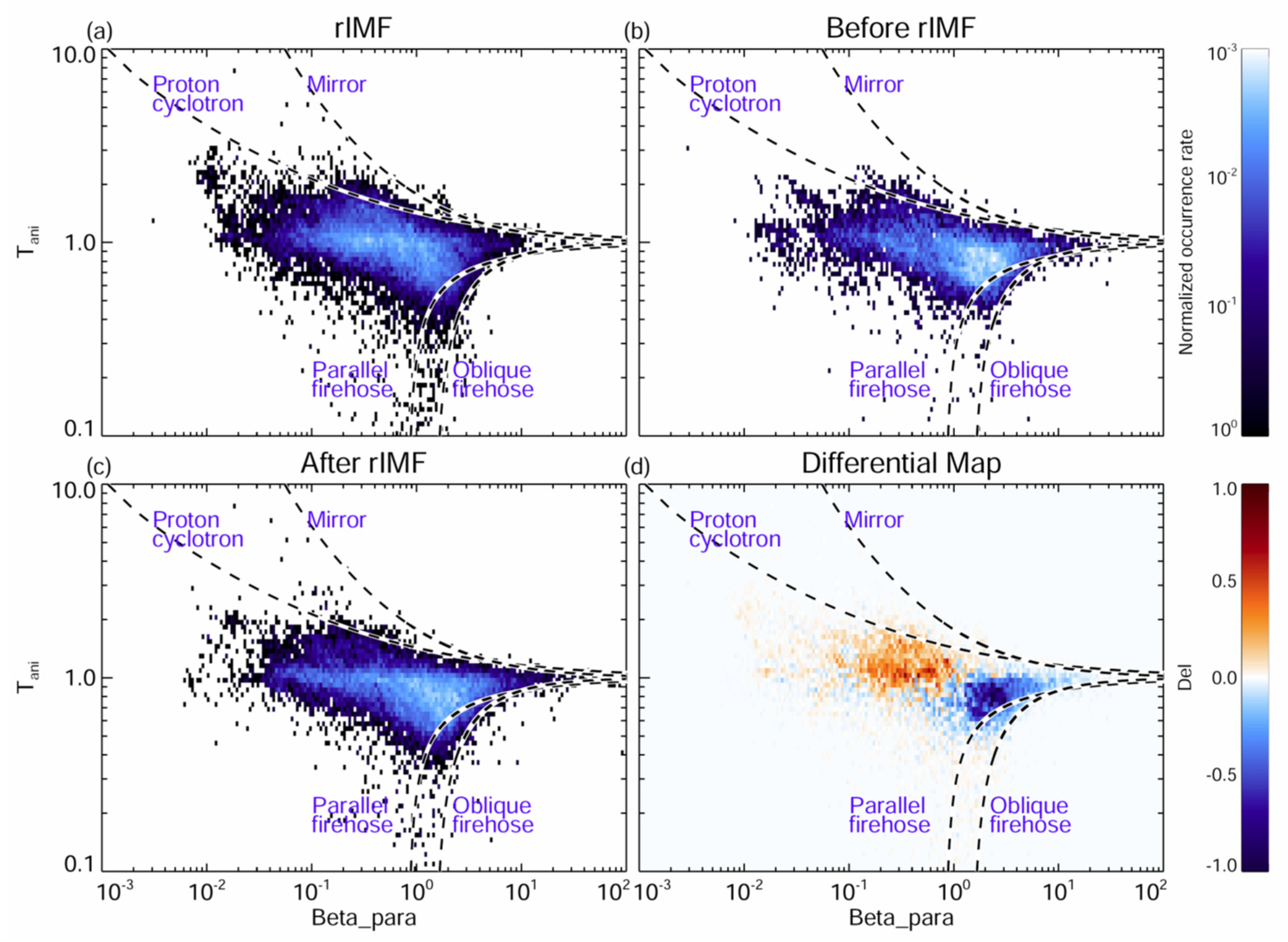
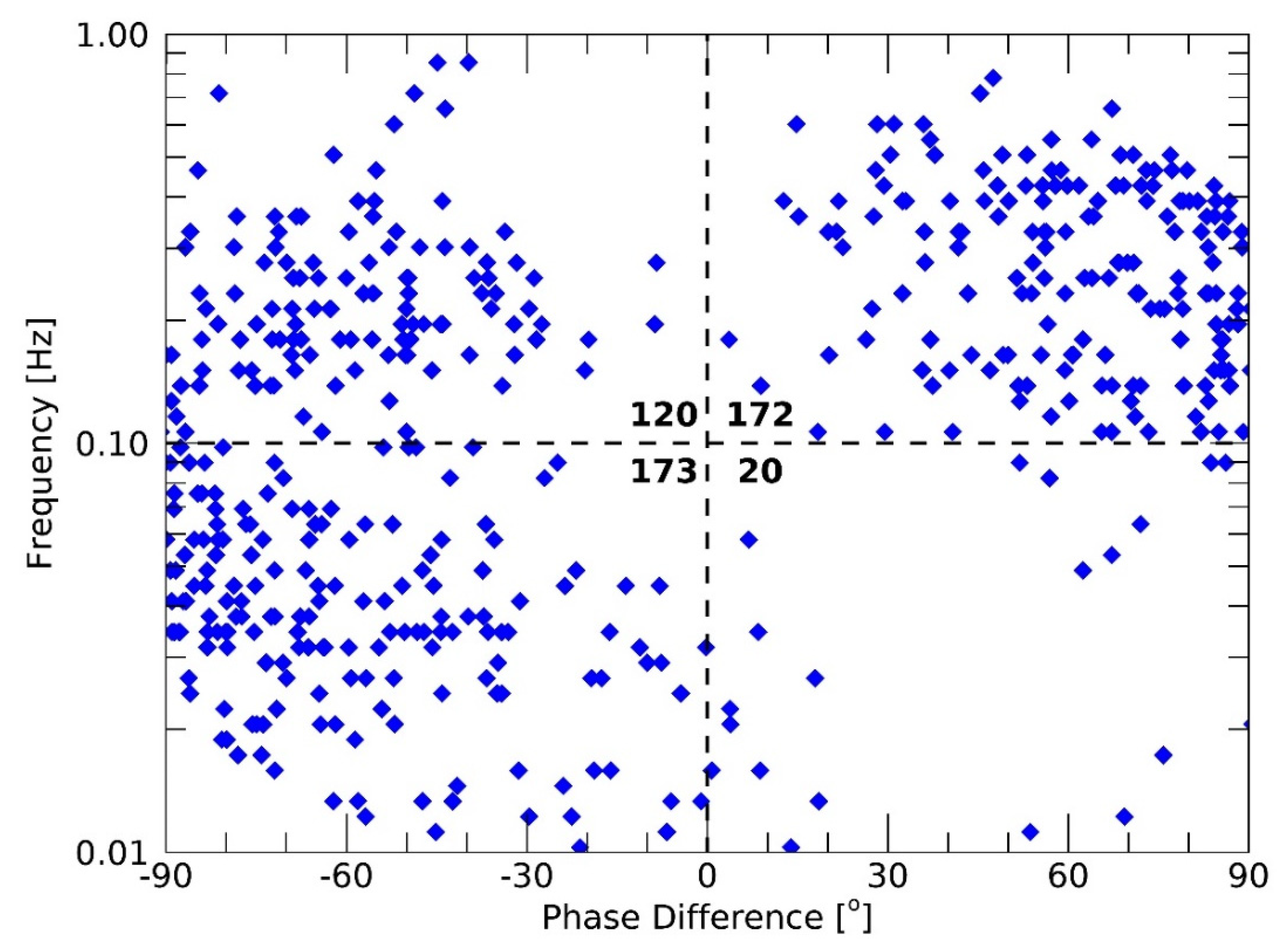
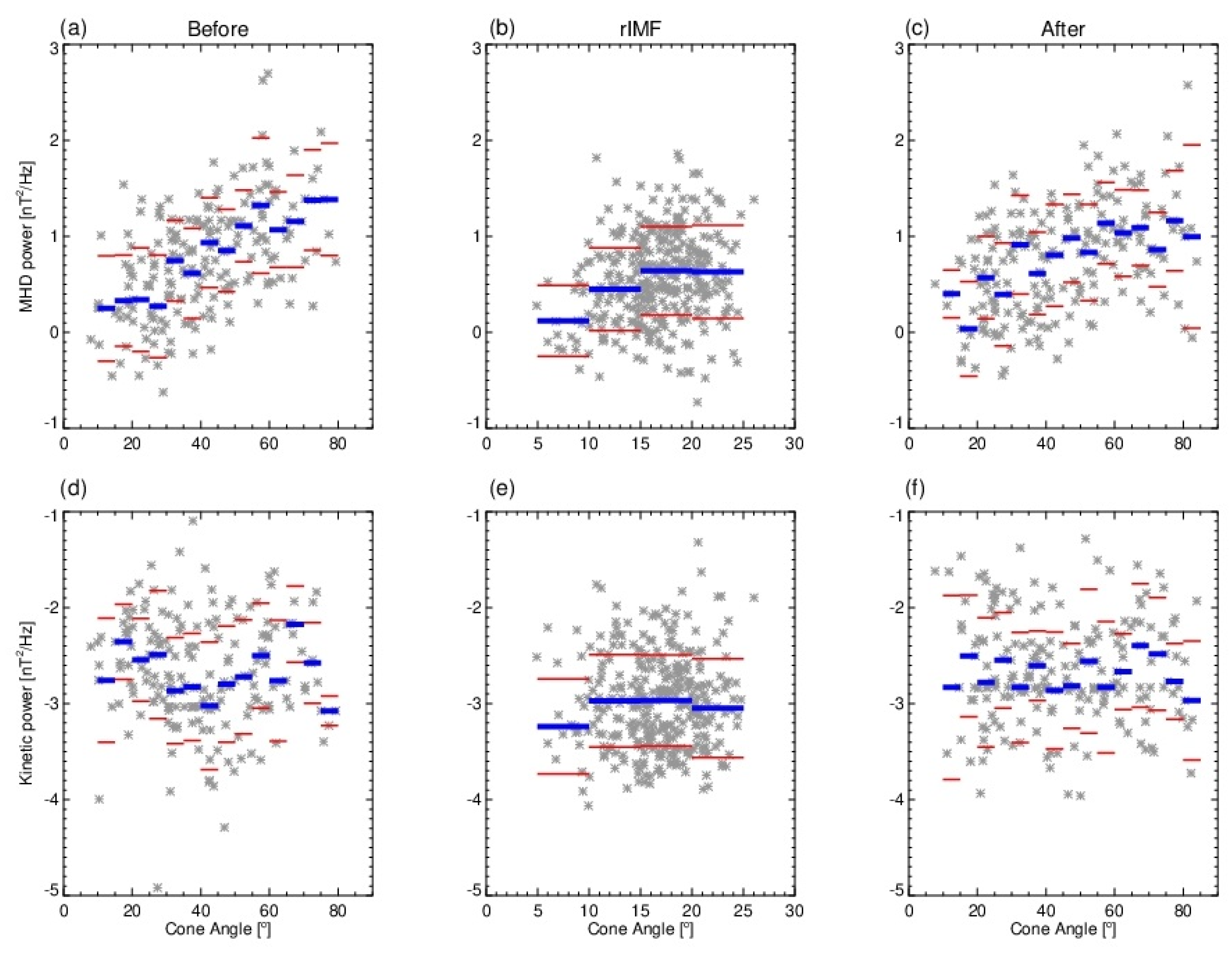

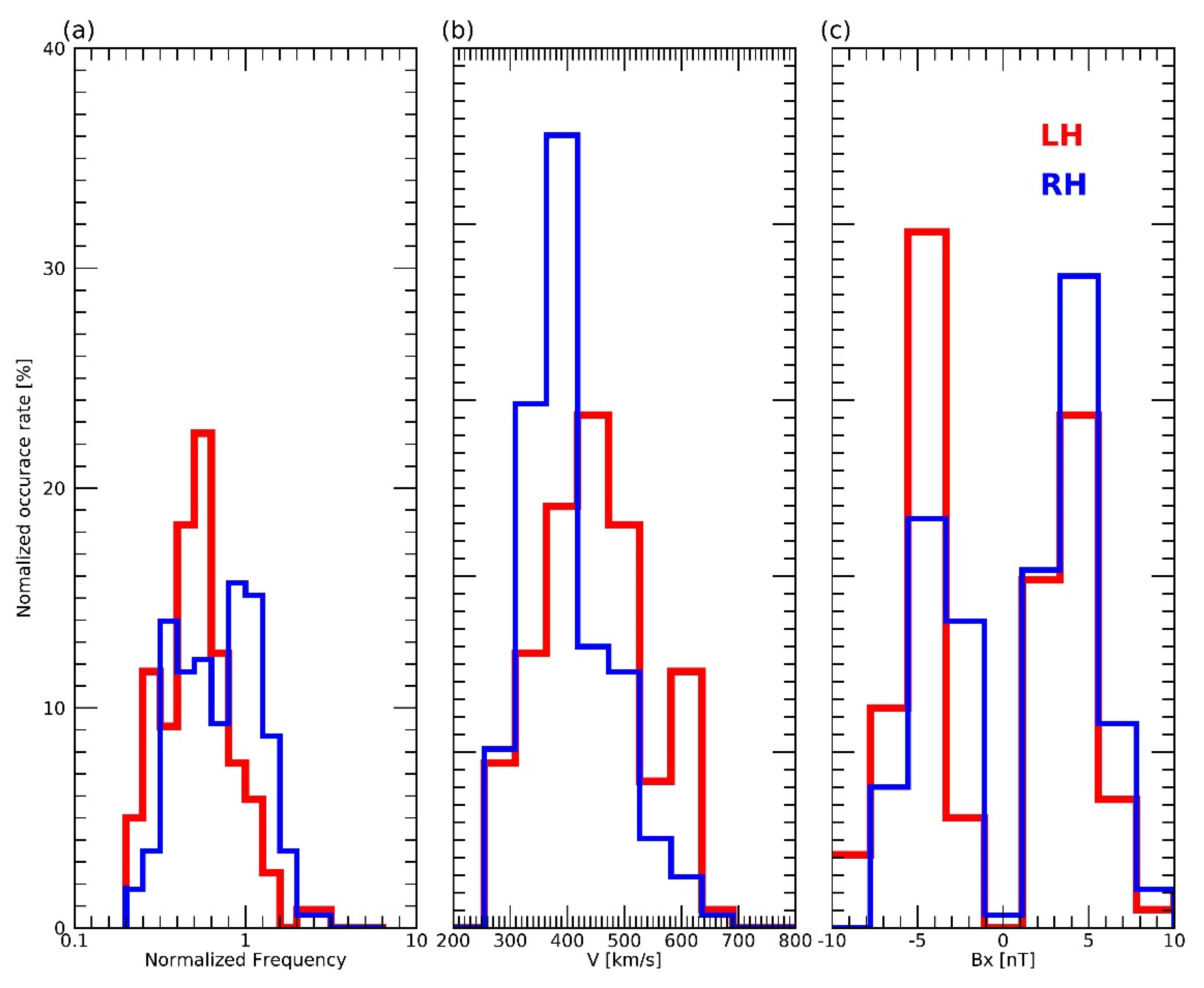
Publisher’s Note: MDPI stays neutral with regard to jurisdictional claims in published maps and institutional affiliations. |
© 2022 by the authors. Licensee MDPI, Basel, Switzerland. This article is an open access article distributed under the terms and conditions of the Creative Commons Attribution (CC BY) license (https://creativecommons.org/licenses/by/4.0/).
Share and Cite
Pi, G.; Pitňa, A.; Zhao, G.-Q.; Němeček, Z.; Šafránková, J.; Tsai, T.-C. Properties of Magnetic Field Fluctuations in Long-Lasting Radial IMF Events from Wind Observation. Atmosphere 2022, 13, 173. https://doi.org/10.3390/atmos13020173
Pi G, Pitňa A, Zhao G-Q, Němeček Z, Šafránková J, Tsai T-C. Properties of Magnetic Field Fluctuations in Long-Lasting Radial IMF Events from Wind Observation. Atmosphere. 2022; 13(2):173. https://doi.org/10.3390/atmos13020173
Chicago/Turabian StylePi, Gilbert, Alexander Pitňa, Guo-Qing Zhao, Zdeněk Němeček, Jana Šafránková, and Tsung-Che Tsai. 2022. "Properties of Magnetic Field Fluctuations in Long-Lasting Radial IMF Events from Wind Observation" Atmosphere 13, no. 2: 173. https://doi.org/10.3390/atmos13020173






